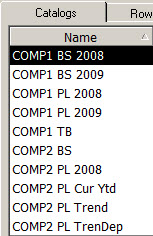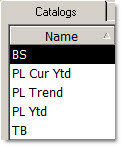This is the second in a series of posts on simplifying FRx.
In almost every existing FRx implementation, I run across opportunities to simplify, meaning reduce, the number of catalogs (aka reports). That often translates to fewer rows, columns, and trees. I really love doing this because it means the client ends up with way less maintenance. Here’s an example with catalogs Before and catalogs After.
Before Simplify:
(…continued for Companies 3 & 4)
After Simplify:
So we went from many reports down to 5, and there are actually MORE options in the After shot because any company can run all reports. Here’s the gist:
- We ended up with 1 balance sheet, 3 flavors of P&L, and a trial balance—and any company can run any catalog.
- If all companies use the same chart of accounts, they can probably share catalogs.
- By default, FRx won’t print an account with a zero balance, so your row format can include accounts from multiple companies.
- You can change a report’s company by using the Company dropdown box just below the Catalog ID.
- Or you can add a tree and run all companies at the same time.
- You can also add a departmental tree as needed. Or not.
- There’s usually no benefit to adding the year in the catalog (as shown in the Before picture above).
When should you not combine catalogs?
- If you’re using FRx Launcher, then you might have to have separate catalogs. Test before making changes.
- If the companies are in different industries, all bets are off: bite the bullet and use separate building blocks and maintain separate reports.
- Maybe if you’ve got lots of FRx users…just depends on circumstances.
You can also streamline and reduce the number of reports by effective use of reporting trees. I’ll post on that soon!


Leave a Reply